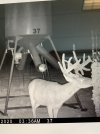In my area - if you want to see deer, you have to manage them or hope your neighbor does - in spite of what our G&F allows or desires hunters to do. We have a six deer limit, two of which may be bucks. There are four of us, plus grandkids, that regularly hunt my 300 acres. We could legally kill twenty or more deer. If we did that for a few years, we would be lucky to see a deer. We usually kill a couple of bucks and at most two does - often, no does. I have 15 adjacent landowners - most who own ten or twenty acres - and manage with a corn feeder and a rifle. Two of the other property owners show some restraint - big property owners - so three of us are managing deer so that all fifteen of us have something to hunt. The three of us improve habitat, plant, feed, and selectively harvest based upon fawn recruitment numbers, buck/doe ratios, buck and doe age, deer density, etc. Many hunters with control of at least some acreage, in my area, would have the same quality and quantity of deer were legal year round. They know if they hunted and harvested as allowed by g&f regulation, quality and quantity would suffer


